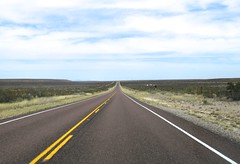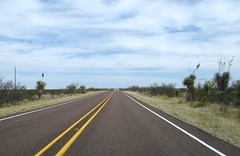A Transect in the Middle of Nowhere
It is axiomatic that iNaturalist observations haven’t blanketed the globe yet, although certain areas are well-covered. In Texas, it is evident that observers and their observations are concentrated around the many urban centers and the array of parks, preserves, and refuges scattered across the state. Where there are not substantial urban centers and few/no public lands, there are often large gaps in our coverage. This includes large swaths of the High Plains and Panhandle along with the wide open spaces in the Trans-Pecos. This is also the case even where there is public road access. Some long stretches of road just don’t get the attention they deserve.
Such is the case for Hudspeth County, sandwiched between El Paso and the popular destinations of Big Bend and the Guadalupe Mountains. For example, in all of this county, there are a total of just 234 observations of 134 species of flowering plants to date.
https://www.inaturalist.org/observations?place_id=931&subview=grid&taxon_id=47125
This compares to efforts in such areas as Travis (40,000 observations of 1,766 spp), Harris (36,000 observations of 2,000 spp), and Dallas Counties (22,000 observations of 1,216 spp). Most of the Hudspeth observations are concentrated along/near destinations on I-10 in the south (including the Indio Ranch Research Station*) and US 62/180 in the north of the county.
* https://www.utep.edu/indio/
Having noticed this big “doughnut hole” in observations as I prepared for my westward journey in early April, I made up my mind to add at least a few observations in the vast empty spaces of Hudspeth County. So on the morning of April 9, departing from the Davis Mountains, I chose to drive north on FM 1111 from Sierra Blanca, TX, to its junction with US 62/180. I accomplished an ad hoc roadside transect in the mid-section of this road, in mid-county, extending from—get your county map book out—Gunsight Road to Frederick Road. This 4.4-mi stretch of FM 1111 makes a beeline due north across arid desert flats with a few shallow desert washes—not a vacation destination by any means. Here are two images of habitats along the transect:
As can be seen in the images above, traffic on the road on that Monday morning was almost non-existent, so I drove slowly along and stopped at various spots to document plant diversity and look for any other available critters. The region was still in an extreme drought so flowering plants were hard to come by, but I made a point of documenting all the dominant woody species and succulents and photographed a small selection of hardy Spring wildflowers along the roadsides.
I spent just over one hour along that transect and documented a total of about 26 species of plants and 3 insects. The area will never be considered a hotspot of biological diversity, but now at least there will be a few dots on iNat in the middle of Hudspeth County. My uploads will follow this journal article shortly.










